What Are the Requirements for Accessible Routes?
ADAAG Section 4.3 addresses accessible routes that connect the play area to the school, parking lot, or facility that it serves. Operators or owners of play areas are subject to all the other requirements of the ADA, including the obligation to provide individuals with disabilities an equal opportunity to enjoy the play area provided by that facility.
This section describes the various features of accessible routes within a play area, including location, clear width, slope, and accessible surfaces.
Accessible Routes
An accessible route is a pathway specifically designed to provide access for individuals with disabilities, including those using wheelchairs or mobility devices.
Accessible routes inside the boundaries of play areas are addressed in the play area guidelines. Technical provisions address the width, slope, and surface of both ground level and elevated accessible routes.
The accessible route must connect all entry and exit points of accessible play components. Clear floor space required at play components and maneuvering space can overlap the accessible route. Incorporating additional circulation space around high-use play components creates extra room for movement and accessibility for everyone using the play area.
There are two types of accessible routes:
-
Ground-level
-
Elevated
This ground-level route (above, top) connects ground components and the transfer system which connects elevated components. This elevated route (above, bottom) connects elevated play components on a composite structure.
Ground-Level Accessible Routes
A ground-level accessible route connects play components at ground level.
-
60 inches (1525 mm) minimum clear width
-
1:16 maximum slope
The route may narrow down to 36 inches (915 mm) for a distance of 60 inches (1525 mm). This permits flexibility to work around site design features like existing equipment or trees (below, top). The required 60-inch width enables two wheelchairs to pass each other or to change direction (below, bottom).
Smaller play areas - those that are less than 1,000 square feet (304.8 square meters) - may have ground-level accessible routes that are 44 inches (1120 mm) clear width. A wheelchair turning space must be provided where the route exceeds 30 feet (9.14 mm) in length.
At ground level, objects may not protrude into the 60-inch wide space of an accessible route up to or below the height of 80 inches (2030 mm), measured above the accessible route surface. The 80-inch clearance applies only to the 60-inch accessible route, and is not required for the entire play area. The 80-inch vertical clearance applies to ground-level routes only, and not elevated routes. This allows features like protective roofs and sun shelters to be present.
This play area provides a fun, accessible roadway theme. The protective shelters for the benches have been set outside the boundary of the route, providing the 80 inches of clearance required on the route.
Maximum Slope at Ground Level
The maximum allowable slope for a ground-level accessible route is 1:16.
Berms are sometimes used to provide access to elevated play areas. A berm may be a natural sloped surface that is present in a hilly play area site, or a ground-level route built with slopes.
Designers are encouraged to consider edge protection and handrails on berms where there may be a drop-off. Remember the maximum slope of this "ground-level accessible route" is 1:16.
However, handrails are not required on ground-level accessible routes. This is permitted since the handrails may become a safety hazard in the "use zone."
Accessible Ground Surfaces
Ground surfaces along accessible routes, clear floor or ground spaces, and maneuvering spaces, must comply with the American Society for Testing and Materials (ASTM) F 1951-99 Standard Specification for Determination of Accessibility to Surface Systems Under and Around Playground Equipment. This standard assesses the accessibility of a surface by measuring the work an individual must exert to propel a wheelchair across the surface. The standard includes tests of effort for both straight-ahead and turning movements, using a force wheel on a rehabilitation wheelchair as the measuring device. To meet the standard, the force required must be less than that which is required to propel the wheelchair up a ramp with a slope of 1:14.
When selecting ground surfaces, operators should request information about compliance with the ASTM F 1951-99 standard.
Accessible surfaces can include impact-attenuating tiles made of recycled rubber and engineered wood fiber that meet the ASTM requirements for accessibility and safety. Safety is not compromised for individuals using the play area where both standards are used.
The American Society for Testing and Materials (ASTM) has established safety standards for play areas, including resilient surfaces. For further information or to purchase these standards, contact ASTM, 100 Barr Harbor Drive, West Conshohocken, PA 19428-2959, www.astm.org.
Accessible Surfaces Located In The Use Zone
If located within the use zone, accessible ground surfaces must also be impact attenuating and meet ASTM F 1292-04 Standard Specification for Impact Attenuation of Surface Systems Under and Around Playground Equipment. The "use zone" is a ground level area beneath and immediately adjacent to a play structure or piece of equipment that is designated for unrestricted circulation around the equipment. It is predicted that a user would fall and land or exit the equipment on the surface of the use zone.
Accessible and non-accessible surfaces can be combined to provide variety and excitement in the play area.
Ground surfaces must be inspected and maintained regularly and frequently to ensure continued compliance with the ASTM F 1951-99 standard. The frequency of maintenance and inspection of resilient surfacing depends on the amount of use and the type of surfacing installed.
Engineered wood fiber surfaces will require frequent maintenance to comply with the ASTM F 1951-99 standard because of surface displacement due to user activity or other factors. Designers and operators are likely to choose materials that best serve the needs of each play area. The type of material selected will affect the frequency and cost of maintenance.
At the time of this publication, rubber surfacing and some engineered wood fiber products meet the ASTM F 1951-99 standard. The fact that a specific product meets the ASTM 1951-99 standard does not necessarily mean that all other similar products will meet the standard. Operators interested in selecting surfaces to comply with the play area guidelines should consult individual product manufacturers to determine compliance with ASTM F 1951-99.
Elevated Accessible Routes
An elevated accessible route is the path used for connecting elevated play components. Elevated accessible routes must connect the entry and exit points of at least 50 percent of the elevated play components provided in the play area. Two common methods for providing access to elevated play components are ramps and transfer systems. Ramps are the preferred method since not all children who use wheelchairs or other mobility devices may be able to use - or may choose not to use - transfer systems.
A typical elevated accessible route might include the following:
-
36-inch (915 mm) clear width
-
32-inch (815 mm) narrowed width permitted for 24-inch (610 mm) length to accommodate features in the composite structure
-
12-inch (305 mm) rise maximum per ramp run
-
Top of handrail gripping surfaces shall be 20 inches (510 mm) minimum to 28 inches (710 mm) maximum above the ramp surface
When Ramps Are Required
Ramps are required on composite structures with 20 or more elevated play components and must connect to at least 25 percent of the elevated play components. Ramps allow individuals who use wheelchairs and mobility devices to access elevated play components in composite play structures without transferring.
This play area has more than 20 play components and provides ramp access to elevated play components. The ramp system, consisting of ramp runs and landings, must connect at least 25 percent of the elevated play components. The balance of the elevated play components required to be on an accessible route may be connected by the ramp system, or by a transfer system.
Rise of a ramp is the amount of vertical distance the inclined or slanted surface ascends or descends. A ramp run is a length of a continuous sloped surface that is ascending or descending. For example, to reach a 12-inch high deck or platform, a designer could use a 12-foot ramp with the maximum 1:12 slope, or a 14-foot ramp with a less-steep 1:14 slope.
Platform lifts, also known as "wheelchair lifts," may be considered for providing access to elevated play components when appropriate. Where applicable, platform lifts complying with ADAAG section 4.11 and applicable state and local codes are permitted as a part of an accessible route. Because lifts must be independently operable, owners and operators should carefully consider the appropriateness of their use in unsupervised settings.
Ramps
Ramps serve as a continuation of the accessible route from the ground allowing individuals who use mobility
devices to access elevated components. For each elevated ramp run:
-
12-inch (305 mm) maximum rise
-
1:12 maximum slope
-
36-inch (915 mm) minimum clear width
Maneuvering Space Where Ramps are Provided
At least one maneuvering space must be provided on the same level as the play component. The space must have a slope no steeper than 1:48 in all directions. The ADA and ABA Accessibility Guidelines address additional requirements for ramps and landings including edge protection, cross slope, surfaces, and outdoor conditions.
Landings
Landings are the level surfaces at the top and bottom of each ramp run.
-
Must be as wide as the ramp they connect to
-
A minimum length of 60 inches (1525 mm)
-
If ramps change direction, the minimum landing size must be 60 inches (1525 mm) wide to accommodate a turn
Handrails
Handrails are required on both sides of ramps connecting elevated play components. Handrails must comply with the following:
-
Clearance between handrail gripping surfaces and adjacent surfaces shall be 1 1/2 inches (38 mm) minimum.
-
Handrail gripping surfaces shall be continuous along their length and shall not be obstructed along their tops and sides. The bottoms of handrail gripping surfaces shall not be obstructed for more than 20 percent of their length. Where provided, horizontal projections shall occur 1 1/2 inches (38 mm) minimum below the bottom of the handrail gripping surface.
Handrails are required to comply with ADAAG 4.8.5. However, extensions on handrails in the play area are not required. This is to prevent children running into protruding rails in the play area.
When Transfer Systems Are Used
A transfer system provides access to elevated play components within a composite system by connecting different levels with transfer platforms and steps. A transfer system provides access to elevated play components without the use of a wheelchair or mobility devices. At least 50 percent of the elevated play components can be connected by a transfer system in play areas with fewer than 20 elevated components. In play areas with 20 or more elevated play components, transfer systems may be used to connect up to 25 percent of the elevated play components and the rest of the elevated play components required to be on an accessible route must be connected by a ramp.
A transfer system typically consists of a transfer platform, transfer steps, and transfer supports.
Where a transfer system is provided, such a combination of transfer platforms and transfer steps provides a continuous accessible route to elevated play components. A transfer system provides individuals the space necessary to physically transfer up or down in a composite play structure. Where provided, a 24-inch (610 mm) minimum width is necessary for individuals moving around a structure.
Consider the distance someone must travel to reach play components accessed by transfer systems. When a transfer system is placed directly next to a slide, for example, access to the elevated play component must be carefully designed to minimize the distance someone must transfer to reach it.
Playful features can be part of the transfer system (above), providing interactive experiences from both an elevated or ground level approach.
Transfer Platforms
A transfer platform is a platform or landing that an individual who uses a wheelchair or mobility device can use to lift or transfer onto the play structure and leave the wheelchair or mobility device behind at ground level.
-
11 inches (280 mm) to 18 inches (455 mm) height of top surface
-
Minimum 24 inches (610 mm) wide
-
Minimum 14 inches (355 mm) deep
-
Unobstructed side
Adding a transfer step that leads to the ground's surface increases access for children exiting components at the ground level.
Clear floor or ground space - used for parking wheelchair or mobility devices (commonly called "wheelchair parking") - is required at the transfer platform. The 48-inch long side (1220 mm) of the "wheelchair parking" space must be parallel to the 24-inch (610 mm) side of the transfer platform.
Transfer Steps
Transfer steps are level surfaces in a composite structure that can be used for transferring from different levels to access play components.
-
Minimum 24 inches (610 mm) wide
-
Minimum 14 inches (355 mm) deep
-
8 inches (205 mm) maximum height
Transfer steps in a play area are not required to satisfy the general ADAAG stair requirements. Maneuvering space and clear space is not required on elevated structures or at elevated play components reached by a transfer system.
Play areas intended for smaller children should provide steps at smaller height increments. This will accommodate smaller sized children who must lift or "bump" up each step.
Transfer Supports
A means of support is required when transferring into the entry or seat of a play component. Transfer supports assist individuals with transferring and general mobility. They include handrails, handgrips, or custom designed handholds. Transfer supports must be provided on transfer platforms and transfer steps at each level where transferring is the intended method of access.
Aesthetically pleasing cutout shapes and other design enhancements can provide hand supports for transferring. Materials in a variety of different shapes and sizes are used to manufacture transfer supports including metal, plastic, and rope.
Materials in a variety of different shapes and sizes are used to manufacture transfer supports including metal, plastic, and rope.
Consideration must be given to the distance between the transfer system and the elevated play components it is intended to facilitate. Designers should minimize the distance between the points where a child transfers from a wheelchair or mobility device and the elevated play destination.
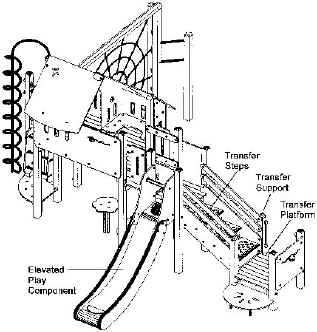
Connected Elevated Components
When transfer systems are used, an elevated play component may connect to other elevated play components, providing an innovative, accessible route.
Consideration should be given to how a play component is utilized when it is selected to connect to other elevated play events. When a transfer system is provided, children move through a play component (such as a crawling tube) using their own strength without a mobility device. Providing variety and excitement through elevated play spaces benefits all children. Tunnels and tubes make "getting there" an activity in itself.
Elevated play components that are connected to other play components count toward fulfilling the requirement for the number of elevated components on an accessible route where transfer systems are used.

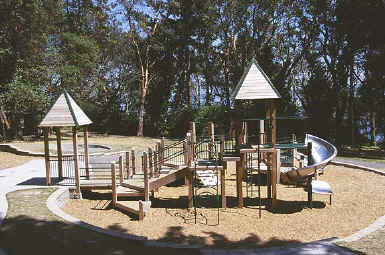
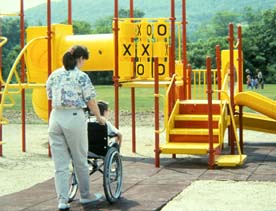
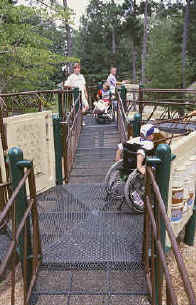
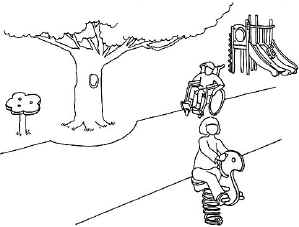
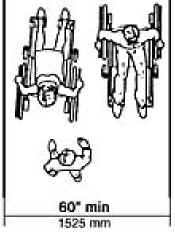
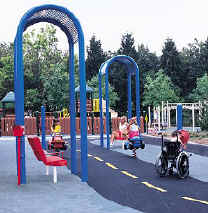
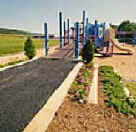
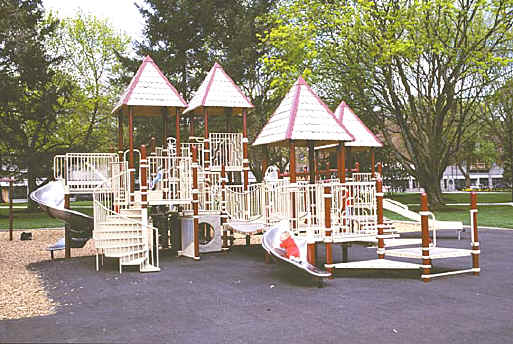
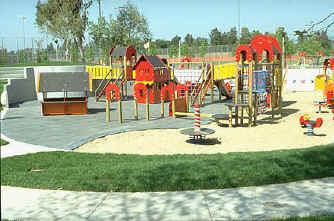
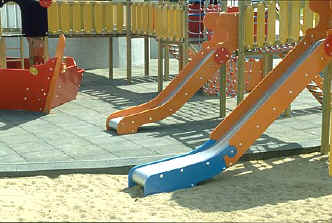
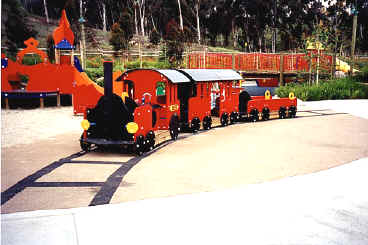
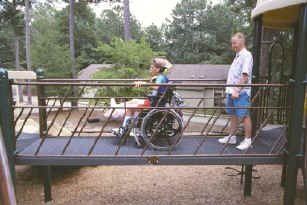
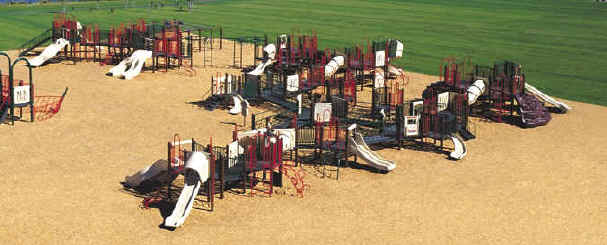
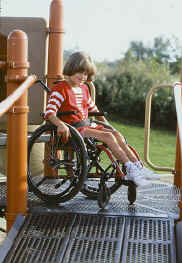
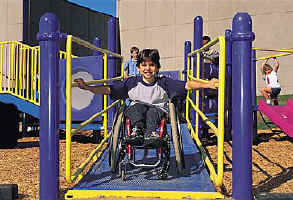
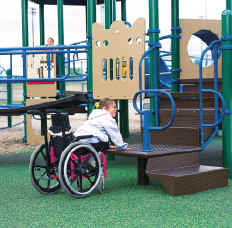
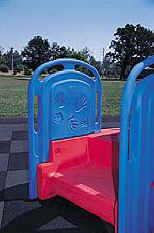
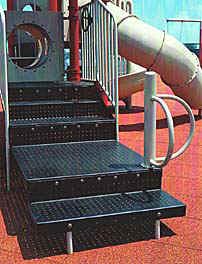
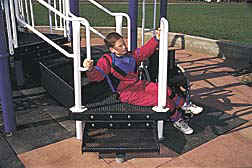
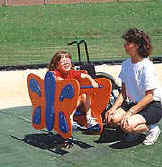
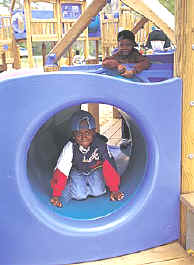
User Comments/Questions
Add Comment/Question